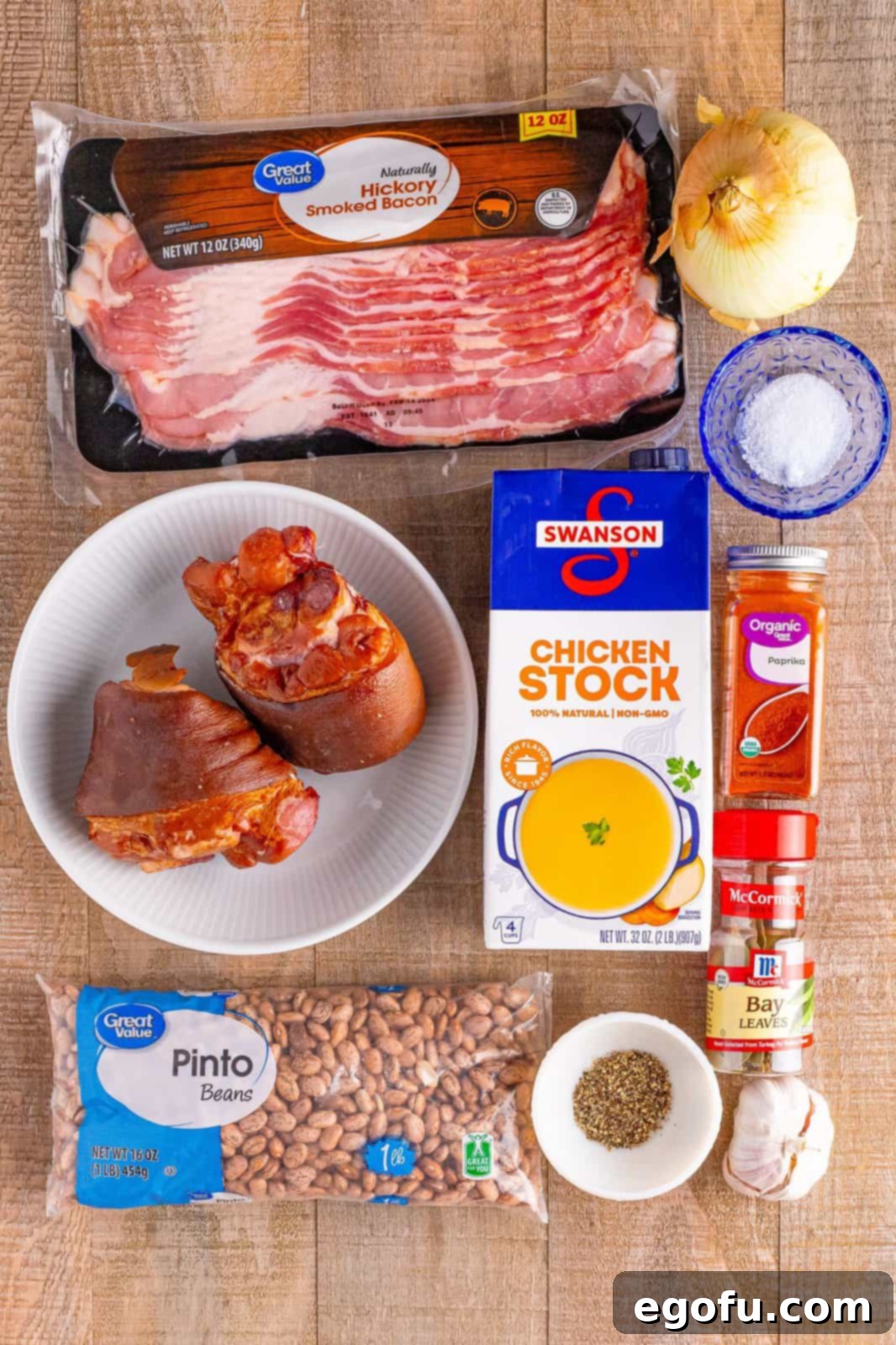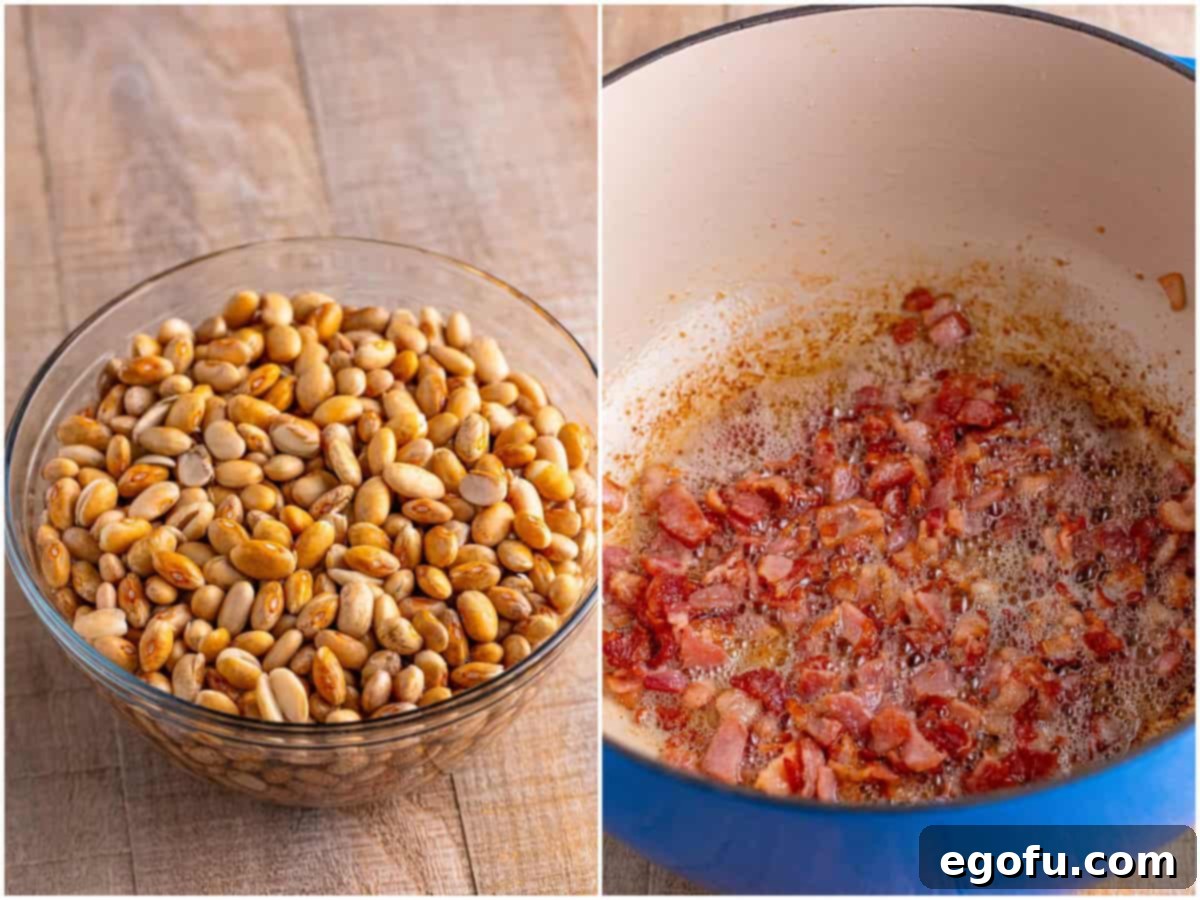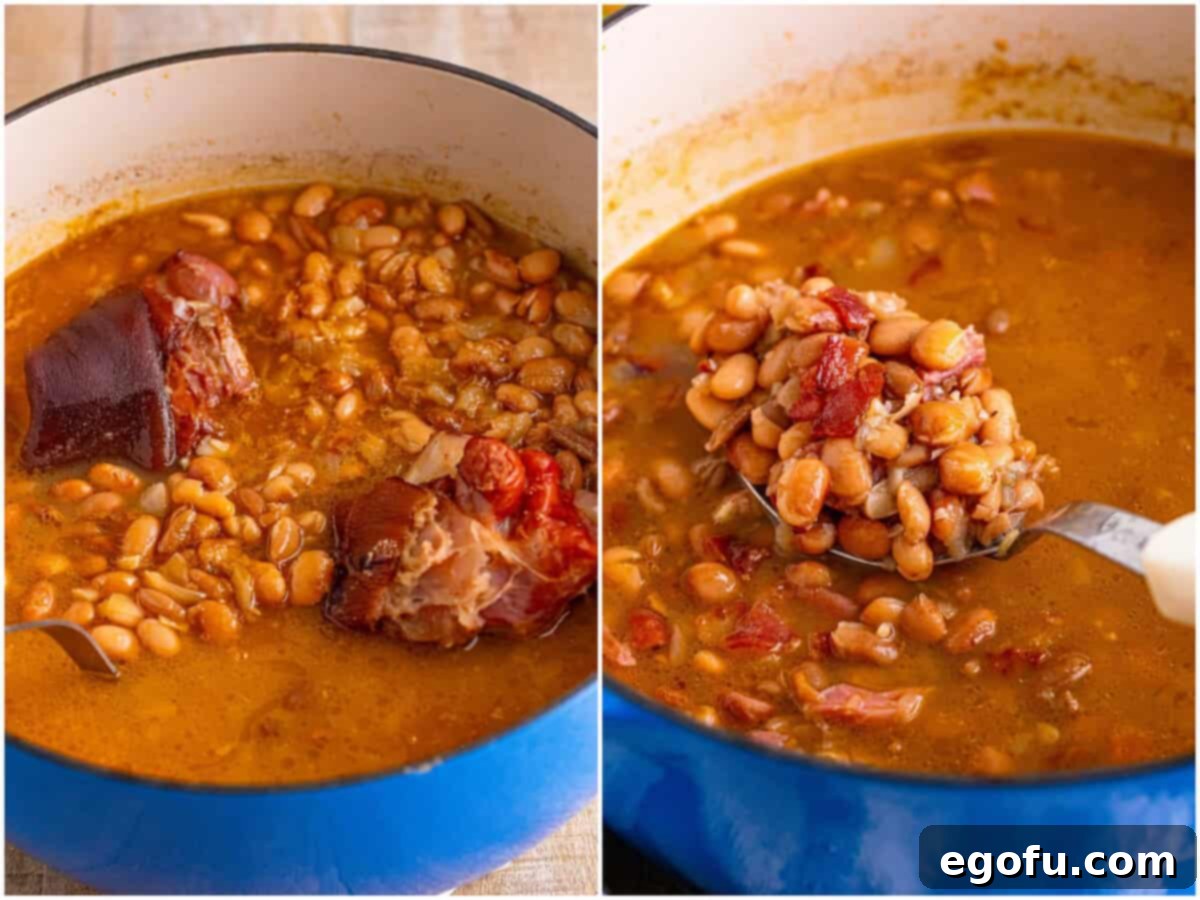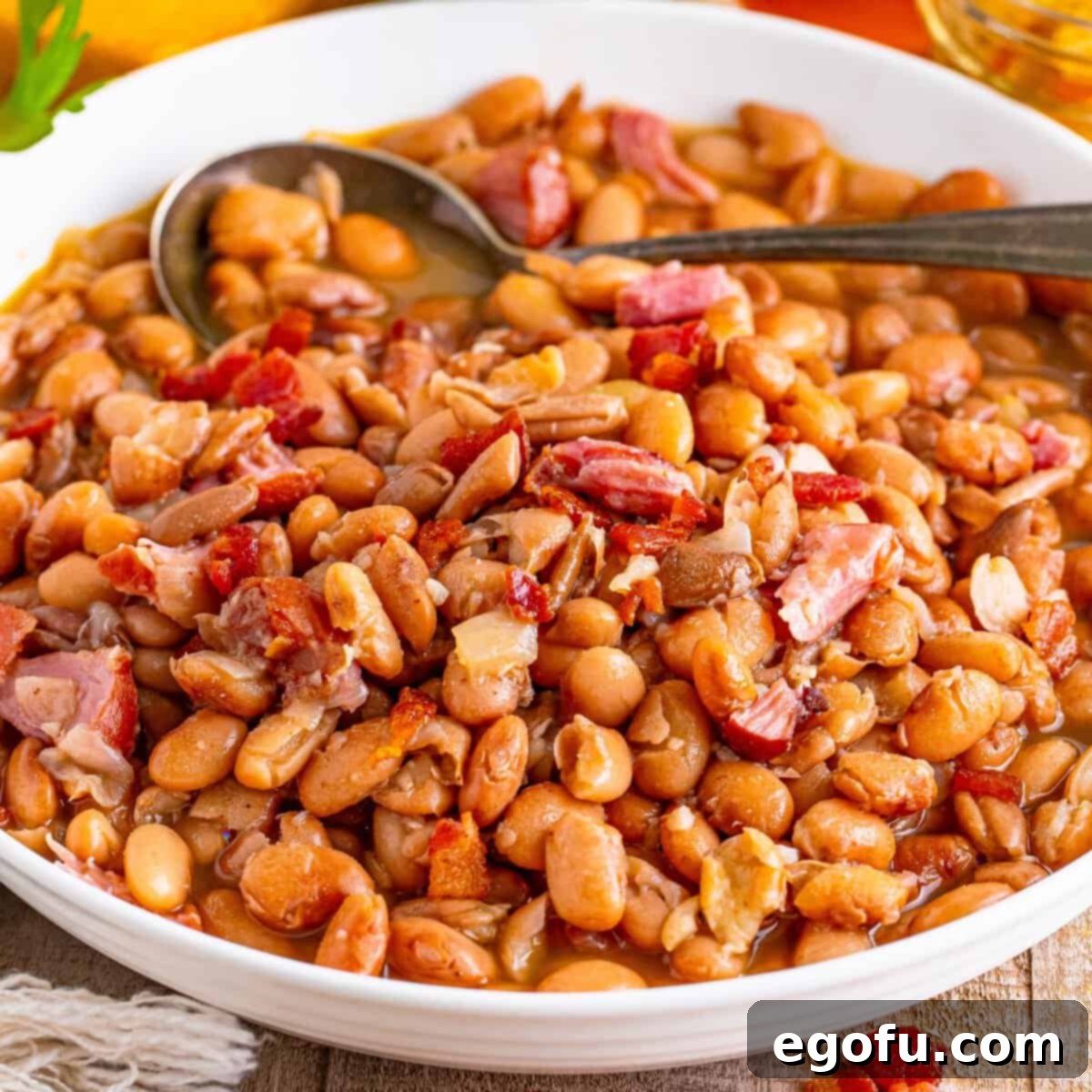The Ultimate Appalachian Soup Beans Recipe: Hearty, Smoky, and Soul-Satisfying
Welcome to the heart of Appalachian culinary tradition with our ultimate Soup Beans recipe. These Appalachian Soup Beans are incredibly flavorful, wonderfully warm, and carry a delightful hint of smokiness, embodying all the delicious comfort you expect from a cherished regional dish. More than just a meal, this recipe offers a taste of heritage, bringing generations together around a pot brimming with wholesome goodness.
A HEARTY APPALACHIAN MEAL: A Culinary Journey into Comfort
If you’ve ever spent time in the charming hills and valleys of Appalachia, then this dish needs no introduction. Appalachian Soup Beans are a true staple, a testament to resourceful cooking, and a beacon of warmth in many homes. This humble yet incredibly satisfying pinto bean recipe is guaranteed to fill every belly and warm every soul, making it a perfect centerpiece for either a busy weeknight dinner or a relaxed Sunday lunch.
This recipe is particularly ideal if you find yourself with a leftover ham bone you’re looking to put to good use – it’s the secret to unlocking unparalleled depth of flavor. With just a few basic pantry ingredients and minimal hands-on effort, you can transform simple pinto beans into the most flavorful, tender, and comforting dish you’ve ever eaten. It’s a dish that embodies the spirit of Appalachian hospitality and good, honest food.


This recipe tastes exactly like how my Maw Maw made them! No one knew exactly how she made them because she never used a recipe and sadly none of us really took the time to pay close attention. This made my heart sing and I will be making this again and again!
– Sherry
FREQUENTLY ASKED QUESTIONS: Unlocking the Secrets to Perfect Soup Beans
Appalachian Soup Beans are a beloved regional dish, primarily featuring pinto beans. They are slow-cooked in a rich, savory broth, traditionally flavored with a ham bone or ham hocks, until they become incredibly tender and the liquid thickens into a comforting “soupy” consistency. The name itself perfectly describes this hearty, simple, and deeply traditional meal that has been a cornerstone of Appalachian cuisine for generations. It’s a dish born out of necessity and a knack for creating extraordinary flavor from humble ingredients.
Traditionally, Appalachian Soup Beans are served generously scooped over a slice of warm, homemade cornbread, which soaks up all the flavorful broth beautifully. They are often topped with a sprinkle of finely diced raw onions, adding a fresh, sharp bite, and/or a spoonful of Chow Chow. Chow Chow is a tangy, southern-style relish, popular in Appalachian regions and increasingly enjoyed throughout the Southern states, providing a bright, acidic contrast to the rich beans. You might also find them served alongside collard greens or a simple coleslaw.
While some modern recipes offer shortcuts, soaking your dried pinto beans overnight (or for a minimum of 8 hours) is highly recommended for traditional Soup Beans. This crucial step significantly reduces the overall cooking time, helps the beans cook more evenly, and can also make them easier to digest. Soaking allows the beans to absorb water, leading to a creamier texture and preventing them from splitting during the long simmer. It’s a small investment of time that pays off in a superior final product.
For the most authentic and robust flavor profile, the combination of both ham hocks and bacon is truly exceptional. Ham hocks provide that deep, smoky, umami base that is quintessential to traditional Soup Beans, while bacon adds an extra layer of savory richness and a delightful textural contrast when crumbled on top. However, if you prefer, you can certainly use just one or the other. If you choose to omit the bacon, we highly recommend cooking the diced onion in 2 tablespoons of butter instead of bacon fat. This will help replace some of the richness and flavor that the bacon would otherwise contribute to the dish.
Absolutely! Making Soup Beans in a slow cooker is a fantastic way to achieve tender beans with minimal fuss, though some adjustments are needed. We still advise cooking the bacon until crispy and softening the onions in a pan first, as this crucial step builds foundational flavor before transferring them to the Crockpot. After soaking your beans thoroughly, add all ingredients to the slow cooker and cook on low for 4-6 hours, or until the beans are exceptionally soft and creamy. Keep in mind that slow cooking retains more liquid, so your final dish might be slightly thinner than the stovetop version, as less evaporation occurs.
While ham hocks are the traditional choice and lend an unmistakable flavor, you do have several excellent alternatives. A smoked turkey neck can provide a similar depth of smoky flavor, especially if you’re looking for a slightly leaner option. A leftover ham bone with some meat still clinging to it is another superb choice, infusing the beans with rich pork essence. Even a piece of fat back can contribute a wonderful savory element. The key is to use a smoked pork product that will slowly release its flavor into the broth, creating that iconic taste.
Reheating leftover Appalachian Soup Beans is simple and they often taste even better the next day! For the best results and to maintain optimal texture, gently reheat them on the stovetop over low to medium heat, stirring occasionally. If the beans have thickened considerably overnight, you may need to add a splash of chicken stock or water to reach your desired consistency. You can also reheat individual portions in the microwave, ensuring to stir halfway through to heat evenly.
Proper storage is key to enjoying your delicious leftovers. Once cooled, transfer your leftover Soup Beans to an airtight container. They will keep beautifully in the refrigerator for up to 4 days. For longer storage, Soup Beans freeze exceptionally well. Portion them into freezer-safe bags or containers, leaving a little headspace for expansion, and freeze for up to 3 months. Thaw overnight in the refrigerator before reheating.

ESSENTIAL INGREDIENTS FOR AUTHENTIC APPALACHIAN SOUP BEANS
Crafting truly authentic and flavorful Appalachian Soup Beans starts with selecting the right ingredients. Here’s a closer look at what you’ll need and why each component is vital to this comforting dish:
- Dried Pinto Beans: The Heart of the Dish – For an authentic, deeply textured soup beans experience, dried pinto beans are non-negotiable. Their ability to slowly absorb flavors and achieve a creamy consistency is unmatched by canned varieties. If you’re pressed for time and absolutely must use canned, please refer to our Slow Cooker Soup Beans with Ham recipe, which is adapted for that.
- Bacon: A Layer of Savory Richness (Optional, but Recommended) – While traditionally a humble dish, the addition of chopped bacon elevates these soup beans to the next level. Cooking the bacon first renders out delicious fat that forms the flavorful base for sautéing aromatics, and the crispy bits make a fantastic garnish. We find the added flavor and texture irresistible.
- Small Sweet Onion: The Aromatic Foundation – A mild onion is preferred here to provide a sweet, aromatic base without overpowering the delicate bean flavor. If a sweet onion isn’t available, a regular yellow onion will work wonderfully, offering a robust foundation for the soup.
- Fresh Garlic Cloves: Aromatic Depth – For the best possible flavor, always opt for fresh garlic, minced, over jarred versions. While optional in some traditional soup bean recipes, fresh garlic adds a pungent, aromatic depth that truly enhances the overall savory profile of the dish.
- Chicken Stock or Broth: The Flavorful Liquid Base – Chicken stock or broth forms the essential liquid base for our soup. It infuses the beans with savory chicken flavor from the start. For those mindful of sodium intake, a low-sodium chicken stock or broth is an excellent alternative. You can even make your own homemade chicken broth for a truly personalized touch.
- Ham Hocks: The Smoky Essence – These are the cornerstone of authentic Appalachian Soup Beans, imparting an irreplaceable smoky, salty, and savory depth. They slowly release their rich flavor as the beans simmer, creating a broth that’s simply irresistible. Be sure to check our FAQ section above for excellent substitution options if ham hocks are unavailable.
- Bay Leaf: Subtle Herbaceousness – A single bay leaf contributes a subtle, herbaceous note that complements the smoky flavors beautifully. If you don’t have one on hand, don’t worry – your soup will still be delicious, but it’s a lovely addition for that extra layer of seasoning.
- Sweet Paprika: Color and Mild Flavor – Sweet paprika adds a warm, inviting color and a mild, peppery sweetness to the beans. If you’re looking to truly amp up the smoky essence of this dish, consider using smoked paprika instead for an even deeper flavor profile.
- Black Pepper: Essential Seasoning – A foundational seasoning that balances and enhances all the other flavors.
- Salt: To Taste – Always adjust salt at the end of cooking, as ham hocks and chicken stock contribute significant sodium.

STEP-BY-STEP GUIDE: HOW TO MAKE AUTHENTIC APPALACHIAN SOUP BEANS
Follow these detailed steps to create a pot of truly soul-satisfying Appalachian Soup Beans that will impress everyone at your table:
- Prepare the Pinto Beans: Sort and Soak
Begin by carefully going through your dried pinto beans, spreading them out and inspecting them to ensure there are no small rocks or debris. This step is crucial for food safety and enjoyment. Once sorted, place the cleaned beans into a large bowl. Add enough cold water to completely cover the beans by at least 2 inches. Cover the bowl loosely with plastic wrap and let it sit at room temperature for a minimum of 8 hours, or ideally, overnight. This soaking process is vital for proper cooking and digestibility. - Cook the Bacon: Build the Flavor Base
In a large Dutch oven or heavy-bottomed pot, cook the chopped bacon over medium heat. Stir occasionally, allowing it to become wonderfully crispy, which should take about 10-15 minutes. Once crispy, use a slotted spoon to carefully remove the bacon pieces, reserving them on the side for garnish later. Leave the rendered bacon fat in the Dutch oven – this is where much of your flavor will begin! - Sauté the Aromatics: Onion and Garlic
Add the diced sweet onion to the reserved bacon fat in the Dutch oven. Cook, stirring occasionally, until the onion has softened and turned translucent, a process that typically takes about 10 minutes. As you stir, make sure to scrape any delicious browned bits from the bottom of the pot – these are packed with flavor. Next, add the minced garlic and cook for just about 30 seconds, or until it becomes fragrant. Be careful not to burn the garlic, as it can turn bitter quickly. - Combine and Simmer: The Heart of the Dish
Drain the soaked pinto beans thoroughly and add them to the Dutch oven with the sautéed aromatics. Pour in the chicken stock, then add the ham hocks, bay leaf, sweet paprika, and black pepper. Stir all the ingredients together to ensure they are well combined. - Slow Cook to Perfection: Achieve Tender Beans
Bring the mixture to a gentle boil over medium-high heat. Once boiling, reduce the heat to low, cover the Dutch oven, and let it simmer slowly for 1-2 hours. The goal is for the beans to become exceptionally soft and creamy, and for the liquid to thicken slightly into that signature “soupy” consistency. Stir occasionally to prevent sticking and ensure even cooking. - Finish and Serve: The Final Touches
Once the beans are tender, carefully remove the ham hocks from the pot. Allow them to cool slightly, then shred any edible meat from the bones and return the delicious meat to the pot. Discard the bay leaf. Taste the soup beans and add salt as needed, remembering that ham and stock can be quite salty. Serve immediately, garnished with the reserved crispy bacon pieces, and enjoy this ultimate Appalachian comfort food!





SERVING SUGGESTIONS & PERFECT PAIRINGS
Appalachian Soup Beans, while delicious on their own, truly shine when paired with their traditional accompaniments. The most classic pairing is with a warm slice of cornbread, which acts as a perfect vehicle for soaking up the rich, flavorful broth. For an added layer of freshness and a delightful textural contrast, a sprinkle of finely diced raw onions is highly recommended. Many also enjoy adding a dollop of Chow Chow, a tangy relish that cuts through the richness of the beans with its bright, vinegary notes. For a complete Southern comfort meal, consider serving alongside collard greens, coleslaw, or even fried potatoes.
PRO TIPS FOR THE BEST APPALACHIAN SOUP BEANS EVER
Elevate your Appalachian Soup Beans from great to absolutely unforgettable with these expert tips:
- Adjust Seasoning Throughout: Always taste and adjust seasoning, especially salt, at various stages of cooking. Ham hocks and broth contribute sodium, so wait until the end to add more salt to prevent over-salting.
- Achieve Your Desired Consistency: If your soup beans are too thin for your liking after simmering, you can gently mash some of the beans against the side of the pot with a spoon or potato masher. This will naturally thicken the broth without needing any added thickeners.
- The Slow Cooker Advantage: As mentioned in our FAQs, a slow cooker can produce incredibly tender beans with minimal supervision. Just remember to sauté your bacon and onions first on the stovetop to lock in those foundational flavors before transferring everything to the slow cooker.
- Boost the Smoky Flavor: If your ham hocks aren’t as smoky as you’d like, or if you’re using a less smoky alternative, you can add a small dash (1/4 to 1/2 teaspoon) of liquid smoke at the end of cooking. Alternatively, using smoked paprika instead of sweet paprika will infuse a deeper smoky essence.
- Vegetarian/Vegan Adaptations: For a meat-free version, omit the bacon and ham hocks. Use vegetable broth and add a generous amount of smoked paprika and a touch of liquid smoke for that desired smoky depth. Sauté onions and garlic in olive oil or vegan butter.
- Don’t Rush the Simmer: The beauty of soup beans lies in their slow simmer. This extended cooking time allows the beans to break down, absorb flavors, and create a truly creamy, comforting broth. Patience is key for this dish!
STORING AND REHEATING LEFTOVERS: Maximizing Freshness
One of the best things about Appalachian Soup Beans is how well they keep, often tasting even better the next day as the flavors meld and deepen. Ensure your leftovers are stored properly to enjoy them for days to come.
- Refrigeration: Once your soup beans have cooled completely, transfer them to an airtight container. They will stay fresh and delicious in the refrigerator for up to 4 days.
- Freezing: For longer storage, soup beans are an excellent candidate for freezing. Divide the cooled beans into individual portions in freezer-safe containers or heavy-duty freezer bags. Be sure to leave about an inch of headspace if using containers, as liquids expand when frozen. They can be stored in the freezer for up to 3 months. Thaw frozen beans in the refrigerator overnight before reheating.
- Reheating: To reheat, gently warm the beans on the stovetop over low to medium heat, stirring frequently to prevent sticking. You may need to add a splash of chicken broth or water to thin them out if they’ve become too thick. For a quicker option, individual servings can be reheated in the microwave, stirring halfway through for even heating.
CRAVING MORE SOUTHERN-INSPIRED RECIPES?
- Southern Black Eyed Peas Recipe
- Classic Red Beans and Rice
- Hearty Senate Bean Soup
- Comforting White Bean Soup with Ham
- Easy Slow Cooker Refried Beans
- Slow Cooker Soup Beans and Ham
- Sweet and Savory Calico Baked Beans
- Perfect Sweet Cornbread
- Tangy Southern Chow Chow
- Traditional Country Ham with Red Eye Gravy
- Flavorful Crock Pot Baked Beans

Appalachian Soup Beans
An affordable, hearty, and deeply satisfying Appalachian dish perfect for any meal.
Cook Time: 6 hours 25 minutes
Soak Time: 8 hours
Author: Brandie Skibinski
Ingredients
- 1 pound dried pinto beans
- 6 slices bacon, chopped (optional, for flavor and garnish)
- 1 small sweet onion, diced
- 4 cloves garlic, minced
- 6 cups chicken stock (low sodium if preferred)
- 2 ham hocks
- 1 bay leaf
- ½ teaspoon sweet paprika
- 1 teaspoon black pepper
- Salt, to taste
For serving:
- Cornbread
- Sliced fresh onions
- Chow Chow (optional relish)
Instructions
- Go through 1 pound dried pinto beans to ensure no rocks or debris. Place them into a large bowl. Add enough cold water to cover the beans by 2 inches. Cover with plastic wrap and let sit at room temperature for 8 hours or overnight.
- Drain the beans well and set aside.
- In a Dutch oven, cook 6 slices chopped bacon over medium heat until crispy (10-15 minutes). Reserve the bacon fat. Remove bacon pieces with a slotted spoon and set aside for serving.
- Add 1 small diced sweet onion to the Dutch oven with bacon fat. Cook, stirring occasionally, until softened (about 10 minutes), scraping up any browned bits.
- Add 4 cloves minced garlic and cook until fragrant (30 seconds).
- Add 6 cups chicken stock, the drained beans, 2 ham hocks, 1 bay leaf, ½ teaspoon sweet paprika, and 1 teaspoon black pepper. Stir to combine thoroughly.
- Bring the mixture to a boil, then reduce heat to low. Cover and simmer for 1-2 hours, or until the beans are very soft and the liquid has thickened slightly.
- Carefully remove the ham hocks. Shred any meat from the bones and return it to the pot. Discard the bay leaf.
- Taste and add salt as needed. Serve immediately with cooked bacon on top, along with cornbread, sliced onions, and/or chow chow if preferred.
Video
Notes
- Please refer to our FAQ’s (Frequently Asked Questions) and the detailed ingredient list above for alternative substitutions or answers to common cooking questions.
Cuisine: American
Nutrition
Carbohydrates: 46g |
Protein: 31g |
Fat: 19g |
Sodium: 483mg |
Fiber: 9g |
Sugar: 6g
Nutritional Disclaimer
“The Country Cook” is not a dietician or nutritionist, and any nutritional information shared is an estimate. If calorie count and other nutritional values are important to you, we recommend running the ingredients through whichever online nutritional calculator you prefer. Calories and other nutritional values can vary quite a bit depending on which brands were used.
Did you make this recipe? Share it on Instagram @thecountrycook and mention us #thecountrycook!
